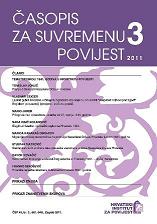Hrvatska seljačka stranka u dubrovačkom kotaru 1941. godine
THE CROAT PEASANT PARTY IN THE DISTRICT OF DUBROVNIK IN 1941
Author(s): Franko MiroševićSubject(s): History
Published by: Hrvatski institut za povijest
Keywords: Croatian Peasant Party; Ustaša Movement; Vladko Maček; Ante Pavelić; National Liberation Movement; District of Dubrovnik; Dubrovnik
Summary/Abstract: The dissolution of the Croat Peasant Party (HSS) in the district of Dubrovnik began in the mid 1930s. Some of the leading members of the HSS in the Dubrovnik organization were dissatisfied with the policies of Vladko Maček and the leadership of the Party. They were dissatisfied with the manner in which the Croatian question was settled through agreement with the Serbian regime parties. They sought after a sovereign and independent Croatia. This policy drew them closer to the Croatian nationalists who were tied to the émigré Ustaša movement. They represented a kind of faction within the district organization of the HSS right up until the destruction of the Kingdom of Yugoslavia. At that time there was no leftist option in the Dubrovnik area which could tie itself to the Croat or Yugoslav Communists. The invasion and occupation of Yugoslavia brought about a turning point. This group of disaffected HSS adherents whole heartedly welcomed the formation of the NDH and eagerly entered the ranks of the Ustaša movement, accepting the functions offered to them in the apparatus of the state administration and other public, political, social, and economic structures of the NDH. In June 1941, the Ustaša government brought forth a law which prohibited all political parties and their organizations. Thus the HSS was put outside the law. About 41.21 % of the prominent members of the HSS accepted the NDH and entered its administrative structures and other bodies. Since the Ustaša movement did not have wider backing among the masses before the war (particularly among the peasantry), they were in need of this support, thus by promotion they attempted to entice the peasantry into their organization and tear them from the HSS, a party to which they had been for the most part attached. In the Dubrovnik district this activity began in July 1941, even before Janko Tortić (one of the prominent prewar leaders of the HSS), together with 126 lesser officials of the party and a significant portion of the popular representatives and their alternates, issued a statement on 10 August 1941 as former members of the HSS declaring that they were joining the Croatian Ustaša movement. Since the pronouncements of the peasants of the Dubrovnik region were primarily declarative, but also most likely carried out under force, their statement did not have any positive results for the Ustaša movement in that region. The peasant continued to be passive because this attitude guaranteed the greatest security. Otherwise, 45.27% of the membership of the prewar HSS organization in the Dubrovnik district continued in 1941 to follow the leadership of the party. During 1941 further dissolution did not occur because the National liberation movement (Narodnooslobodilački pokret, NOP) took on only 13.51% of the prewar leadership of the HSS. The largest number of those who joined NOP were on Pelješac and these, for the most part, were lower functionaries in the party hierarchy...
Journal: Časopis za suvremenu povijest
- Issue Year: 43/2011
- Issue No: 3
- Page Range: 881-893
- Page Count: 13
- Language: Croatian

